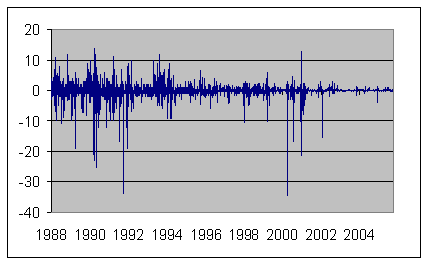For an updated version of this document, see the “-paged”- Prediction Markets Timeline.
–
CHRONOLOGY &- HISTORY: Prediction Markets Timeline
–
Feel free to post a comment or contact me, and I’-ll correct or add a factoid. Thanks.
–
#1. Historical Prediction Markets
According to Paul Rhode and Koleman Strumpf, prediction markets almost never got it wrong forecasting the 19 presidential elections that took place from 1868 to 1940. (PDF)
#2. The three Iowa Electronic Markets founders (Robert Forsythe, Forrest Nelson and George Neumann)
“-We ran our first market in 1988. We didn’t have regulatory approval at that point so we were restricted solely to the University of Iowa community. We had under 200 traders and under $5,000.”- –- [Robert Forsythe – PDF file]
– [CFTC’s no-action letter to the IEM – 1992 – PDF file]
– [CFTC’s no-action letter to the IEM – 1993 – PDF file]
#3. Robin Hanson
a) Robin Hanson set up and ran a rudimentary prediction exchange (a market board, PPT file) in January 24, 1989. The outcome to predict was the name of the winner of a Poker party.
b) Until evidence of the contrary, it seems that Robin Hanson was the first to set up and run a corporate prediction exchange —-at Xanadu, Inc., in April 1989. See: A 1990 Corporate Prediction Market + Anonymity is important for employees trading on internal prediction markets.
Robin Hanson: “-I started a market at Xanadu on cold fusion in April 1989. In May 1990, I started a market there on whether their product would be delivered before Deng died.”-
c) Until evidence of the contrary, it seems that Robin Hanson was the first to set up and run a bunch of imagination-based prediction markets. See the Murder Mystery Evening described by Barney Pell —-circa June 8, 1989.
d) Until evidence of the contrary, it seems that Robin Hanson was the first to write a paper on prediction markets created and existing primarily because of the information in their prices (as opposed to markets created primarily for speculation and hedging).
Could Gambling Save Science? –- (Reply to Comments) –- by Robin Hanson –- 1990-07-00
Market-Based Foresight: a Proposal –- by Robin Hanson –- 1990-10-30
Idea Futures: Encouraging an Honest Consensus –- (PDF) –- by Robin Hanson –- 1992-11-00
e) Robin Hanson godfathered the Foresight Exchange (created in 1994) and NewsFutures (created in 2000).
f) Robin Hanson invented the concepts of decision markets (PDF) and decision-aid markets.
g) Robin Hanson invented a new market design (for the 2000-2003′-s Policy Analysis Market), the Market Scoring Rules, a mix between CDA and Scoring Rules —-now in use for most enterprise prediction markets and public, play-money prediction exchanges. Note that MSR is mainly used in a one-dimension version, but many researchers are interested in its combinatorial version.
#4. Other Pioneering Public Prediction Exchanges (Betting Exchanges, Event Derivative Exchanges) and Inventors/Innovators/Entrepreneurs
a) The Foresight Exchange was founded on September 22, 1994 by Ken Kittlitz, Sean Morgan, Mark James, Greg James, David McFadzean and Duane Hewitt. The Foresight Exchange is a play-money prediction exchange (betting exchange) managed by an open group of volunteers. It pioneered user-created and user-managed, play-money prediction markets. Any person can join the Foresight Exchange and interact with the rest of the Web-based organization. An independent judge (independent from the owner of the claim) should be appointed among the volunteers. [Thus, it’s not “DYI prediction markets”.]
b) The Hollywood Stock Exchange was founded on April 12, 1996, by Max Keiser and Michael Burns. See the patent for the Virtual Specialist. For more info, see: Is HSX the “longest continuously operating prediction market”??? –- REDUX
c) BetFair was founded in 1999 by Andrew Black and Edward Wray, and was launched in England in June 2000. As of today, BetFair is the world’-s biggest prediction exchange (betting exchange, event derivative exchange).
d) NewsFutures was founded in March 2000 and launched in September 2000 in France and in April 2001 in the US by Emile Servan-Shreiber and Maurice Balick. See: NewsFutures Timeline. NewsFutures was the first exchange to let people buy or sell contracts for each side of a binary-outcome event. The advantage of this design is that it avoids the need for “-shorting”-, a notion that tends to confuse novice traders. NewsFutures later extend that approach to deal with n-ary outcome events while implementing automatic arbitrage.
e) TradeSports was launched in Ireland in 2002 by John Delaney. InTrade was later purchased and became a non-sports prediction exchange (betting exchange). As of today, InTrade is the biggest betting exchange on the North-American market —-where betting exchanges are still illegal. As for TradeSports, it closed at the end of 2008, alas.
#5. The Policy Analysis Market Brouhaha
a) Robin Hanson was the main economist behind the 2000–2003 US DoD’-s DARPA’-s IAO’-s FutureMAP–Policy Analysis Market project. (For this project, Robin Hanson invented a new market design, the Market Scoring Rules.) On July 28, 2003, two Democratic US Senators called for the termination of PAM, the the big media gave airtime to their arguments, and the US DOD quickly ended the IAO’-s FutureMAP program.
b) The second branch of the 2000–2003 US DoD’-s DARPA’-s IAO’-s FutureMAP program was handled by the Iowa Electronic Markets and was intended to predict the SARS pandemic. (This project later gave birth to IEM’-s Influenza Prediction Market.)
#6. James Surowiecki’-s The Wisdom Of Crowds
a) James Surowiecki’-s book, The Wisdom Of Crowds, was published in 2004.
b) Impact of The Wisdom Of Crowds.
#7. Recent Public Prediction Exchanges (Betting Exchanges, Event Derivative Exchanges) and Inventors/Innovators/Entrepreneurs
a) US-based and US-regulated HedgeStreet was launched in 2004 by John Nafeh, Russell Andersson, and Ursula Burger. A designated contract market (DCM) and a registered derivatives clearing organization (DCO), HedgeStreet is subject to regulatory oversight by the Commodity Futures Trading Commission (CFTC). In November 2006, IG Group bought HedgeStreet for $6 million.
b) Inkling Markets was launched in March 2006 and co-pioneered (with CrowdIQ, which later bellied up) the concept of DIY, play-money prediction markets.
c) In September 2006, TradeSports-InTrade was the first prediction exchange (betting exchange, event futures exchange) to apply Chris Masse’-s concept of X Groups. See: TradeSports-InTrade prediction markets on Bush approval ratings.
d) HubDub was launched in early 2008 and is the second most popular play-money prediction exchange, behind HSX.
#8. Enterprise Prediction Markets
a) Until evidence of the contrary, it seems that Robin Hanson was the first to set up and run a corporate prediction exchange —-at Xanadu, Inc., in April 1989. See: A 1990 Corporate Prediction Market + Anonymity is important for employees trading on internal prediction markets.
b) In the 1996–-1999 period, HP ran a series of internal prediction markets to forecast the sales of its printers.
c) Eli Lilly sponsored 10 public, industry-level prediction markets in April 2003 (on the NewsFutures prediction exchange).
d) Eli Lilly began using internal prediction markets in February 2004 (powered by NewsFutures).
e) Google‘-s Bo Cowgill published about their use of internal prediction markets in October 2005.
f) Since then, many companies selling software services for enterprise prediction markets have been created.
#9. Disputes Between Traders And Exchanges
a) The scandal of the North Korean Missile prediction market that erupted in July 2006 is, as of today, the biggest scandal that rocked the field of prediction markets.
–
![]()
![]()




